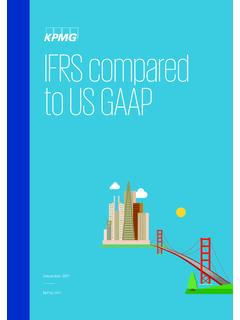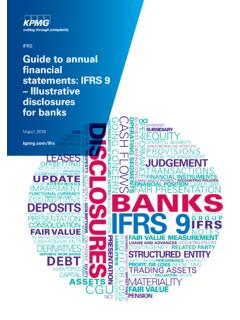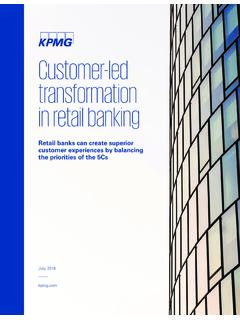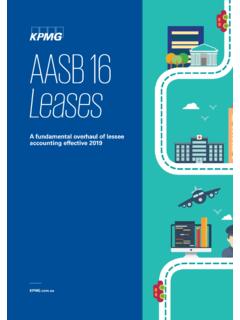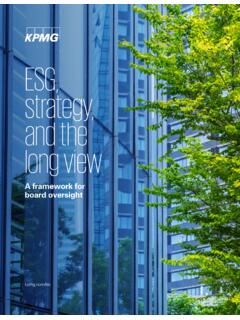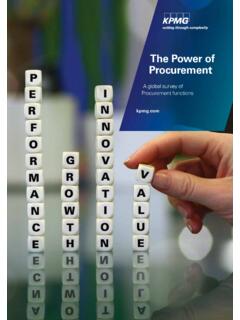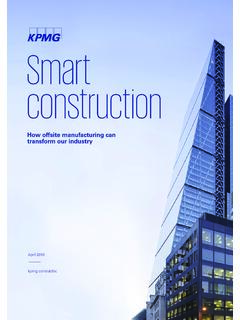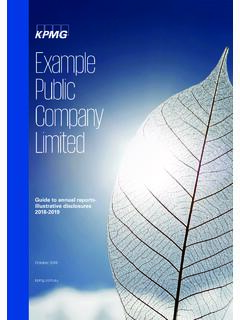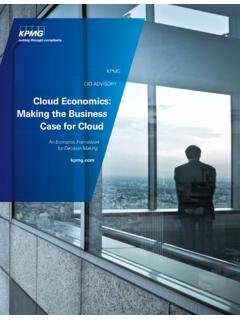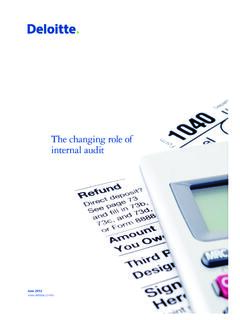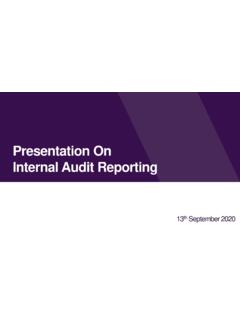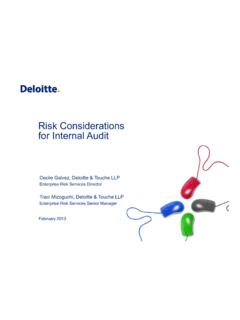Transcription of 20 key risks to consider by internal Audit before 2020
1 20 key risks to consider by internal Audit before 2020 Are you aware of the risks concerning internal Audit today and in the near future?EditorialAn effective and sound risk-based internal Audit plan is one of the most critical components for determining IA s success as a value-adding and strategic business partner. The Institute of internal Auditors (IIA) Standard 2010 Planning states that the Chief Audit Executive must establish a risk-based plan to determine the priorities of the internal Audit activity, consistent with the organization s goals . This publication aims at assisting Chief Audit Executives (CAE) during their annual Audit planning process.
2 Whether provoking thought or facilitating discussions, this publication should assist your governance function to consider a broad range of key risks potentially impacting your organization within the next two years. In order to allow for a comprehensive strategic assessment, it is key to profoundly understand the underlying risk drivers as well as the potential consequences or impact on the organization. It enables the CAE to determine whether a risk is considered key to the organization or if it s something of a nice to have . Once the key risks have been established, this publication provides further insights on how internal Audit should tackle the topic, how it can help the organization during an Audit and what the required crucial skillsets and expertise are in order to ensure an effective, efficient and value-adding outcome by your internal Audit further guidance we have mapped the top 20 risks on a Risk Radar (refer to page 5).
3 The Radar presents two spectrums: 1 Established key risks that should be known by the IA function by now vs. emerging risks which are not yet fully visible regarding magnitude;2 Non-standard/exceptional risks that should be considered for a one-time Audit vs. risks that should be considered on an ongoing basis and form a recurring part of the strategic Audit planBeyond identifying emerging versus established key risks , the Risk Radar also highlights the recommended level of monitoring of key risks . For instance, IT governance, data analytics and mass data usage are risks that should be continuously considered by IA professionals throughout all governance activities.
4 Non-standard/exceptional risks should be considered based on a triggering event ( merger or acquisition) or due to close scrutiny by stakeholders ( organization-wide project).For further information you find the distinctive KPMG subject matter specialists for the respective topics on the last page of this publication. I would like to thank Stephanie F hn for her tremendous support in collecting and establishing the are looking forward engaging with you into interesting discussions as to how the future internal Audit topic and bring in our extensive experience and thought leadership. Luka ZupanPartner, Head of internal Audit , Risk and Compliance Services (IARCS), KPMG SwitzerlandMember of the global KPMG IARCS Collaboration & Knowledge (C&K) Champion Network 2 The strategic role of IA Recent studies highlighted a general misperception regarding the role of internal Audit (IA) within organizations.
5 Traditionally, IA functions have mostly focused on topics related to compliance and internal control systems (ICS). Adding value and providing insights on the key risks of an organization has typically not been a key priority of modern IA function should understand the organization s key risks and proactively identify emerging risks in order to add value to the organization. This allows IA to assist the organization in efficiently and effectively allocating resources to mitigate risks and further develop its strategic publication highlights key risks that IA should consider in the development of the annual strategic Audit plan.
6 It will help IA to prioritize topics and will further enhance IA s role as a strategic and value-adding business partner within the order to select the key risks that matter to the organization and further develop their strategic role within the organization, IA should: Understand key business mattersIA is required to have a profound understanding of the business strategy and operations across all levels of the this is achieved, IA can use its expertise to identify key emerging risks , educate the business and collaborate with it to take advantage of any opportunities. Leverage technologyIA must adapt its methodologies to increasingly utilize technology in the execution of audits.
7 This will provide not only efficiency gains in the delivery of IA but also provide deeper insights into the business, further developing the value perception and credibility of IA. Ensure that IA activities create business value IA must ensure that its activities not only provides assurance but also delivers insights into the business, which may be leveraged to improve the business processes or gain a competitive advantage. consider the source of demand for assuranceDuring the development of the risk-based IA Plan, IA should always consider who is seeking assurance over the specific risk. Once identified, IA should then assess its ability to provide additional insights beyond the stakeholder s current understanding of the topic.
8 This should help IA to prioritize audits which add value and have the potential to provide insights ordinarily not accessible to interested insightinto efficiency and effectiveness46%82%Finds potentialrevenue enhancement, cost savings and/ or smarter CAPEX Spend46%78%Providescompliancefeedback54% 24%Increasescommunicationacross theorganization55%45%Providesoperational feedback60%46%Reveals existingand emerging risks1%0%Other Self-perception by internal Audit professionals External view held by executive stakeholdersSurvey highlighting the differing perceptions of internal Audit within organizations31 Digitalization, Industry & the Internet of Things2 Cloud computing3EU General Data Protection Regulation (EU-GDPR)4 Cyber security5 Business continuity and crisis response6 Net working capital management7 Non-GAAP financial measures8 Data analytics and mass data usage9 Treasury management10 Organization-wide initiatives/projects11 Effective talent management12 Trade environment and customs13 Alignment of operations to organization s strategy and objectives14 Compliance Management Systems (CMS)
9 , auditing organization culture and ethics 15 Effectiveness and efficiency of operational processes16 Mergers, acquisitions, and divestitures17 Integrated enterprise risk management and monitoring18IT governance19 Outsourcing and managing third-party relationships 20 Tax complianceTop 20 risks before 20204 Risk Radar Top 20 risks before 20201234567891011121314151617181920 Non-standard or exceptionalTo be considered on a recurring basisEmergingEstablished key risk Emerging and exceptional risks , categorized as a current, high priority by stakeholders Established and exceptional key risks requiring highly technical & specialized Audit and subject matter expertise Established key risks to be audited on a cyclical basis and considered by management on a continuous basis Emerging risks to be considered on an ongoing basis and included in assurance activities where possible5 Drivers: Growing pressure on the efficiency and quality of operational processing continues to drive organizations towards digitalization and automation.
10 Increasing investments in robotics, machine learning, artificial intelligence and advanced analytics is driving a new form of business transformation that is commonly referred to as Industry drivers and benefits of digitalization include: The increased level of information and transparency achieved through the digitalization of processes. This provides additional context by constructing a virtual copy of the physical production environment to assist management in decision-making. The ability of machines and systems to interface and exchange information without human intervention. The decentralization of decision-making achieved through delegating simple, repetitive decisions to robotics and machine learning systems.
